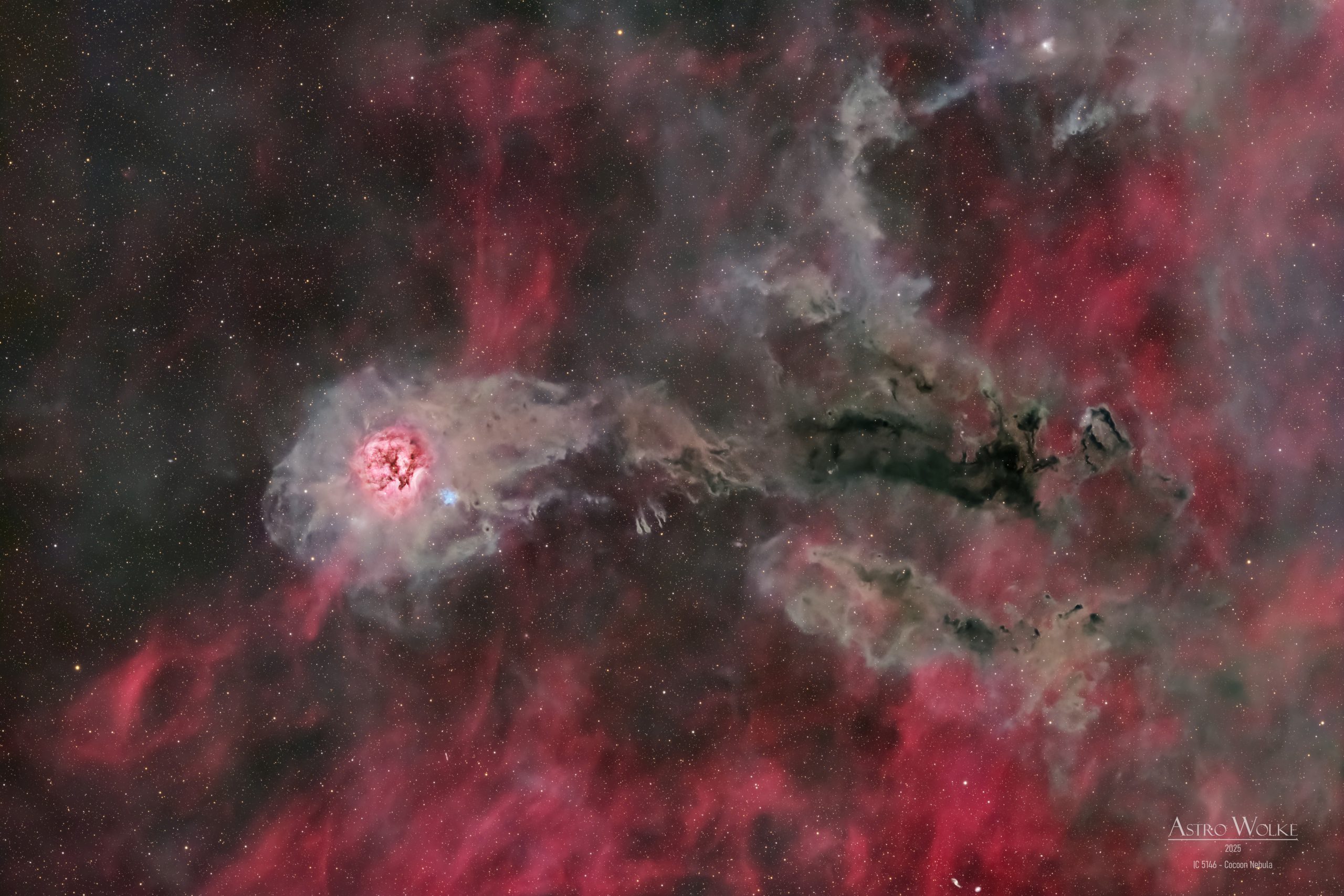Description
The Cocoon Nebula – a Stellar Nursery in Cygnus
In the constellation Cygnus, about 3,300 light-years away from Earth, lies a fascinating object: the Cocoon Nebula, known to astronomers as IC 5146. Its name is fitting, for just like in a cocoon, new stars are being born within this cloud of gas and dust.
The nebula spans roughly 15 light-years across, making it a significant stellar nursery. Its reddish glow comes from hydrogen gas, energized by the radiation of newly formed stars. At the same time, dense lanes of dust absorb the starlight and create dark, intricate patterns across the glowing backdrop.
At the nebula’s center sits a very young, hot star that ionizes the surrounding gas, causing it to shine. In the darker regions around IC 5146, further stars are taking shape, hidden from view, and will emerge as brilliant suns in a few million years.
For amateur astronomers, the Cocoon Nebula is a popular target, as it reveals both sides of the cosmos: the beauty of glowing emission clouds and the mystery of dark nebulae.
Der Kokon-Nebel – eine Sternenwiege im Schwan
Im Sternbild Schwan, etwa 3.300 Lichtjahre von der Erde entfernt, liegt ein faszinierendes Objekt: der Kokon-Nebel, von Astronomen auch als IC 5146 bezeichnet. Schon der Name verrät, was hier geschieht – wie in einem Kokon entstehen in dieser Gas- und Staubhülle neue Sterne.
Der Nebel misst rund 15 Lichtjahre im Durchmesser und ist damit ein beachtlich großes Sternentstehungsgebiet. Sein rötliches Leuchten stammt vom angeregten Wasserstoffgas, das durch die energiereiche Strahlung junger Sterne zum Glühen gebracht wird. Gleichzeitig verdunkeln dichte Staubwolken das Licht und zeichnen verschlungene Dunkelstrukturen in die Himmelslandschaft.
Im Zentrum des Nebels sitzt ein sehr junger, heißer Stern, der das Gas in seiner Umgebung ionisiert und damit das charakteristische Leuchten erzeugt. In den dunklen Bereichen rund um IC 5146 entstehen weitere Sterne, die in einigen Millionen Jahren selbst zu leuchten beginnen werden.
Für Amateurastronomen ist der Kokon-Nebel ein beliebtes Fotomotiv, denn er zeigt die beiden Seiten des Kosmos: die Schönheit leuchtender Gaswolken und zugleich die Geheimnisse verborgener Dunkelnebel.
Conclusion
The Color information was recorded 8,8 hours with the TS-OPTICS 76EDPH at 342mm focal length and F4.5 and the ASI 2600 MC Pro.
Details
Total Integration: 40h 30’
Ha: 186x300s (15h 30’) 10./11./12.08.2025
L: 194x300s (16h 10’) 16./18./20./23.08.2025
L-RGB: 106x300s (8h 50’) – 16./18./20.08.2025
FOV: 3.3° x 2.2
Pixel scale: 1.9″/pixel
Dithering: 2 pixels every image
Gain: 100
Sensor temperature: 0°C
Recording: ZWO ASI 2600MM DUO / ZWO ASI 2600MC
Filter: Baader Luminance 2‘‘ / Baader SHO Ultra Narrowband 2‘‘
Optics: Askar SQA85 (mono) / TS Optics 76 EDPH (RGB)
Guiding: ASI 120 (ZWO OAG-L)
Mount: ZWO AM5N (mono) / Celestron AVX (RGB)
Control: ZWO ASIAIR Plus (mono) / ZWO ASIAIR MINI (RGB) Software: PixInsight + Photoshop
Darks: 30
Flats: 20
Flat-Darks: 20


Comments are closed